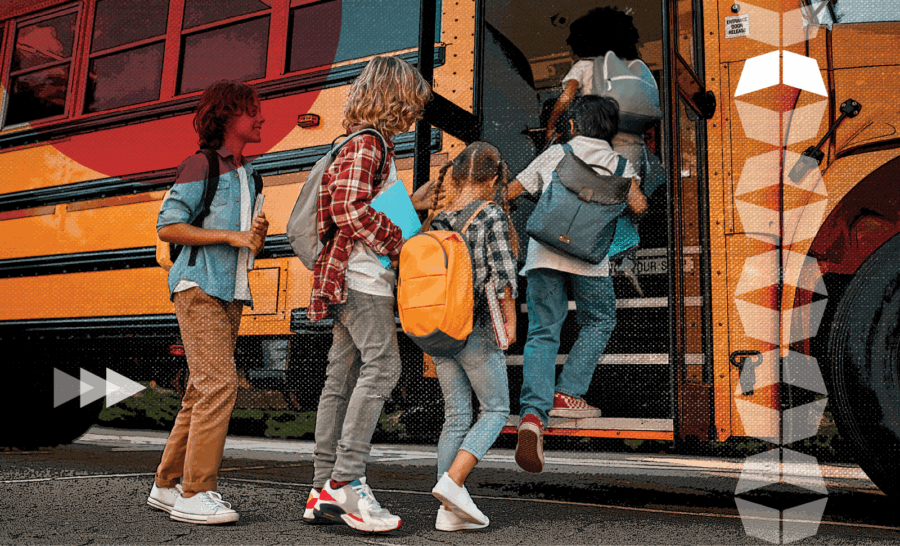Back-to-School Retail 2025: Tips and Trends
Originally posted August 9, 2024, updated August 11, 2025.
While brands catering to students and teachers can always rely on the back-to-school retail season to make a splash as one of the largest retail events of the year, the unpredictability of consumer behaviors, the economy, and emerging trends can keep businesses on their toes.
For some merchants, this uncertainty can feel uneasy, but it doesn’t have to. Embracing evolution is key to success. This article explores top back-to-school retail trends to watch out for, and expert advice on how to lean into the shifts.
Now take out your notepad, class is in session.
In review: The 2024 back-to-school season
Based on Capital One’s Shopping Research, in total, the 2024 back-to-school and back-to-college season brought in $125.4 billion for U.S. retailers, a 7.45% drop from 2023.
A few notable trends:
- Shoppers sought value. Families took a more cautious approach to back-to-school retail shopping: 41% of K–12 shoppers and 37% of college shoppers prioritized buying items on sale, while many compared prices online or opted for generic products.
- Electronics led spending. For both K–12 and college, electronics and computer supplies topped household budgets, averaging $309 for K–12 and $359 for college. Clothing and shoes followed as high-priority categories.
- Early birds multiplied. More than half of back-to-school consumers started shopping by early July, driven by promotional events like Prime Day and the need to spread out budgets. In 2024, 66% of purchases were completed by the end of July, up nearly 12% year over year.
And where did all this shopping occur? Both online and in-store.
In fact, 70% of shoppers split purchases between the two, with 33% using BOPIS and 17% choosing Buy Now, Pay Later. Nearly 60% of consumers visited two to three stores before making final purchases, demonstrating how competitive and multi-channel the back-to-school market has become.
2025 Back-to-school retail trends
Deloitte’s 2025 back-to-school survey found:
Spending holds steady but with caution. Parents plan to spend an average of $570 per child, flat year-over-year, keeping total K–12 market spend around $30.9 billion. Clothing and accessories are the only category seeing growth (+6%), while tech (–8%), school supplies (–3%), and home/health items (–12%) are declining. Lower-income households are spending more due to rising prices, while middle- and higher-income households are cutting back.
Value-seeking dominates behavior. Economic uncertainty is pushing 75% of parents to switch to more affordable brands, 65% to choose lower-cost retailers over preferred ones, and 51% to buy private label. Nearly half planned to shop during Prime Day, 49% will spread purchases over time, and 71% are willing to wait longer for free or cheaper shipping.
Channel mix and retailer preferences. Mass merchants (83%) and online retailers (68%) top the shopping list, with parents visiting an average of five store formats. In-store remains important (32% plan to spend mostly in-store, 24% mostly online) yet online shoppers spend more on average ($601 vs. $501).
Child-driven purchases. Nine in 10 parents say their child has a must-have item, and 62% admit these preferences often lead them to spend more. Over half are willing to splurge on a first-day-of-school outfit.
Other spending priorities. Extracurricular activities remain a priority, with 90% of parents planning to enroll kids, though spending is down slightly to $532 per child. Lunch costs are also a concern, with nearly half of parents expecting higher prices and making tradeoffs like switching to private labels or shelf-stable items.
Generational and tech shifts for 2025 back-to-school retail
Social media and AI are shaping back-to-school retail shopping journeys, especially for Gen Z parents.
- 41% will use social media for back-to-school retail shopping, spending 1.8× more than non-users.
- 33% will use generative AI for deal-finding, list-making, and product discovery, with adoption highest among Gen Z (67%).
- Influencers are highly trusted by younger parents, with 54% of Gen Z saying they offer quality BTS recommendations.
The bottom line: Retailers that deliver value, cater to tech-savvy and social-first shoppers, and offer flexible fulfillment and promotions are best positioned to win in 2025’s cautious yet opportunity-rich back-to-school season.
2025 forecasted trends at-a-glance
| Trend Category | 2025 Insights |
| Average Spend per Child | $570 (flat YoY) |
| Total Market Spend | $30.9B (flat YoY) |
| Category Shifts | Clothing +6%, Tech –8%, Supplies –3%, Home/Health –12% |
| Value-Seeking Behavior | 75% will switch brands, 65% pick cheaper retailers, 51% buy private label |
| Top Shopping Destinations | Mass merchants (83%), Online retailers (68%) |
| Channel Mix | 32% mostly in-store ($501 avg), 24% mostly online ($601 avg) |
| Social Media Influence | 41% use social media; spend 1.8× more than non-users |
| AI Use in Shopping | 33% use AI for deals/lists/discovery; 67% of Gen Z adopt |
| Child-Driven Purchases | 90% kids have must-have item; 62% influence spending |
| Extracurricular Spend | $532 per child (down from $582) |
| Lunch Cost Adjustments | 48% expect higher lunch prices; trade down to cheaper items |
5 back-to-school tips for retailers
Retailers still have time to make strategic shifts to make the most of the 2025 back-to-school retail season, and these five tips can be implemented immediately:
1. Forecast demand sooner rather than later
Thinking a few steps ahead is essential in any industry, but for back-to-school season, it’s a necessity. While it takes a few seasonal cycles and learning from rookie mistakes, retailers must get a handle on inventory management for two reasons: Understocking leads to customer dissatisfaction, and overstocking leads to excess inventory that may be challenging to sell.
Turn to your marketing team to gain rich insights on potential product demand and take account of what’s already in stock. In the long run, this thoughtful pause will save precious time.
By creating space, you can identify slow-moving products, measure your inventory, and de-prioritize non-essential shipments to make way for higher-demand back-to-school items.
2. Meet customers where they are
With online, offline, and social media options for back-to-school retail shopping, businesses must be prepared for consumers to move around between channels, especially since price is top of mind this season.
Take an omnichannel approach by integrating sales channels and offering your products across a variety of mediums. Know exactly where the customer is throughout their buyer journey and adjust marketing messaging accordingly while keeping branding cohesive.
Retailers that are aware of a specific behavior emerging within a certain demographic audiences should switch up their strategy. For instance, if millennial customers prefer to shop in-store vs. online, create and communicate specialized discounts at brick-and-mortar locations, or partner with large (mass) retailers to provide an in-person deal.
It’s also helpful to offer a few buying options that merge the best of both online and offline worlds, such as curbside pickup, or try out trends like live shopping to reach new demographics.
3. Know the audience and segment
Speaking of the audience, know where they are, what they like, and how they shop. A tall order for sure, but not impossible with the data insights available today. While there will be overlap, parents, teachers, and students are all likely looking for different items.
Work with the marketing team to appropriately segment audiences by age, interests, and previous buying behaviors. From there, personalize your paid advertising strategies to get the right message to the right individual.
4. Get your retail compliance ducks in a row
In the retail industry, chargebacks can be a huge setback, especially if back-to-school sales prompt products to fly off the shelves. Even the most organized retailer can get caught up in the madness.
When working with large retailers such as Amazon, Target, and Walmart, and marketplace fulfillment, the best way to avoid pricey chargebacks is by carefully ensuring your retail shipments are in compliance.
This is why it’s crucial to partner with third-party logistics (3PL) supply chain experts who have established relationships with large retailers, can catch the tiny details, and will execute the process seamlessly.
5. Plan now for post–back-to-school momentum
While back-to-school is a high-value retail period, it’s also a springboard into the holiday season, the year’s biggest sales window. Use the insights, sales data, and shopper behaviors gathered during BTS to refine holiday strategy. Ask:
- Which promotions resonated?
- Which channels drove the most conversions?
- Where did inventory or fulfillment processes slow you down?
By evaluating these post-peak KPIs and other factors now, retailers can strengthen holiday campaigns, improve operational efficiency, and ensure their brand stays top-of-mind with customers who just purchased. In short, the end of BTS should be the starting line for holiday readiness.
How to master back-to-school fulfillment
To end the back-to-school season strong, have the right resources ready to get a clear picture of progress and pain points to stay agile and adaptable for next year.
The best way to do this? Partnering with a trusted 3PL to unlock a variety of retail fulfillment services, including:
- Real-time inventory visibility with top-tier responsive fulfillment technology.
- Strong shipping carrier relationships, leading to discounted shipping rates.
- A team of retail compliance experts who connect you with valuable vendors.
- Guidance on how to navigate the EDI process seamlessly with big-box customers.
- Retail-ready packaging for custom POP displays to keep your product moving.
- Access to value-added services (VAS) such as personalization, custom packaging, and unique labeling to drive home your brand identity.
Get back-to-school ready with WSI
As the back-to-school season unfolds, staying in sync with shifting consumer behaviors and retail trends is critical to maximizing sales opportunities. By applying these strategies now, you’ll be better positioned not only to meet immediate seasonal demand but also to carry that momentum into the next peak period; the holiday season.
At WSI, we combine nationwide capabilities with a personalized approach, delivering retail logistics solutions designed to keep your business running smoothly. From precise inventory management to streamlined fulfillment and reverse logistics, our team provides the insights and execution you need to meet customer expectations and drive growth.
Ready to optimize your retail fulfillment strategy? Speak with a WSI retail logistics expert and discover how we can help you deliver value season after season.
About the Author

Alyssa Wolfe
Alyssa Wolfe is a content strategist, storyteller, and creative and content lead with over a decade of experience shaping brand narratives across industries including retail, travel, logistics, fintech, SaaS, B2C, and B2B services. She specializes in turning complex ideas into clear, human-centered content that connects, informs, and inspires. With a background in journalism, marketing, and digital strategy, Alyssa brings a sharp editorial eye and a collaborative spirit to every project. Her work spans thought leadership, executive ghostwriting, brand messaging, and educational content—all grounded in a deep understanding of audience needs and business goals. Alyssa is passionate about the power of language to drive clarity and change, and she believes the best content not only tells a story, but builds trust and sparks action.



